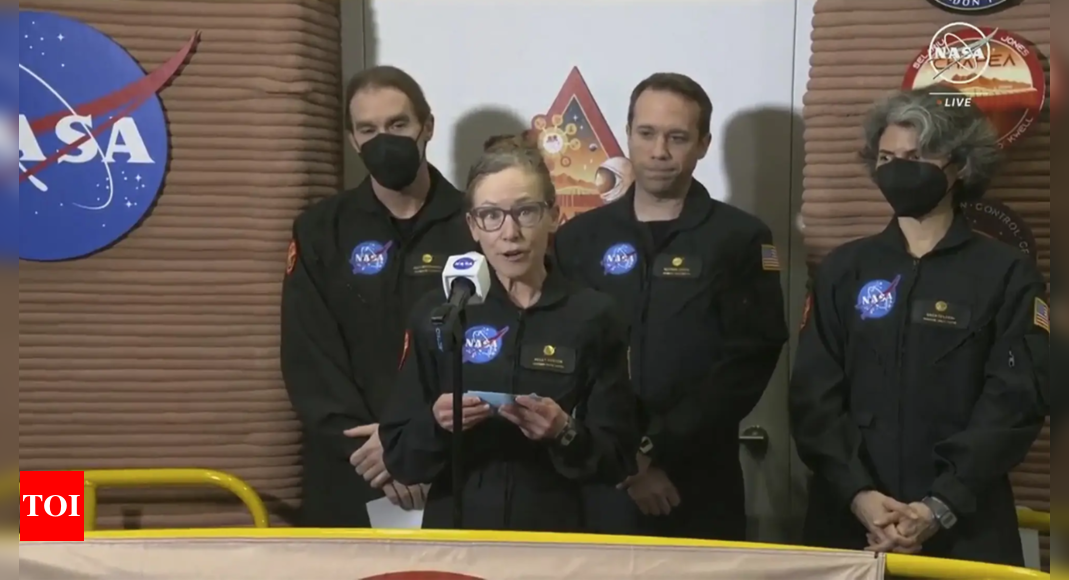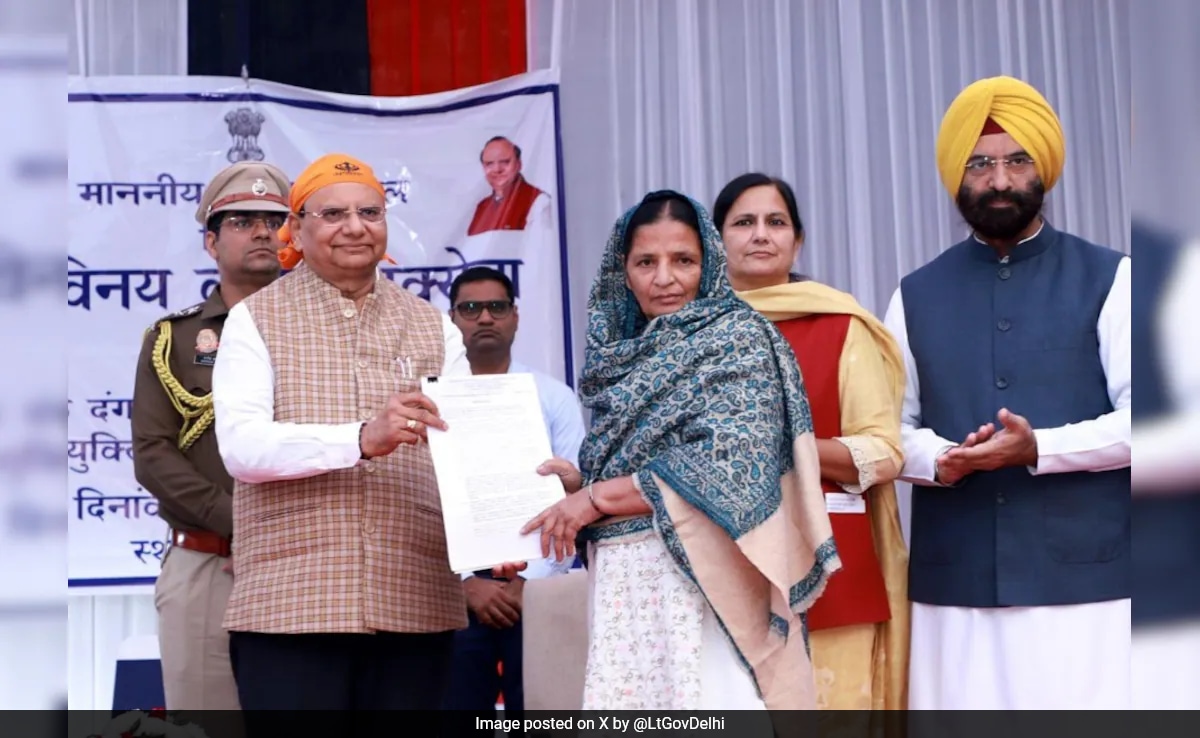
After a year-long simulated voyage to Mars that never left Earth, the crew of a Nasa mission emerged from their craft. The four volunteer crew members spent over 12 months inside Nasa’s first simulated Mars environment at Johnson Space Centre in Houston, exiting the artificial alien environment on Saturday around 5 pm.
On June 25, 2023, Kelly Haston, Anca Selariu, Ross Brockwell, and Nathan Jones entered the 3D-printed habitat as the inaugural crew of the space agency’s Crew Health and Performance Exploration Analog project, according to a report from AP.
“It’s actually just so wonderful to be able to say ‘hello’ to you all,” said Haston, the mission commander, beginning with a simple “Hello.”
Jones, a physician and the mission medical officer, remarked that their 378 days in confinement “went by quickly.”
Four individuals resided and carried out their duties within a 17,000 square feet (1,579 square meters) facility, simulating a journey to Mars, the fourth planet from the sun and a common topic of interest among researchers and science fiction enthusiasts regarding the possibility of human exploration beyond the moon.
The inaugural CHAPEA team concentrated on establishing potential conditions for future Mars missions through simulated spacewalks, referred to as “Marswalks.” They also engaged in cultivating and harvesting vegetables to supplement their food supplies, while maintaining the habitat and their equipment.
The crew faced challenges that a genuine Mars mission would likely encounter, such as limited resources, isolation, and communication delays of up to 22 minutes with Earth on the other side of the habitat’s walls, according to Nasa.
Nasa has announced plans for two more CHAPEA missions, during which crews will continue conducting simulated spacewalks and collecting data on various aspects related to physical and behavioural health and performance.
Steve Koerner, the deputy director of Johnson Space Center, emphasised the significance of the crew’s research, which primarily concentrated on nutrition and its impact on their performance. He described the work as essential for preparing to send humans to Mars.
According to Koerner, the crew members were isolated from their loved ones, subjected to a strict diet, and closely monitored throughout the mission. He highlighted the importance of this project as a crucial step in America’s ambition to lead the global space exploration effort, with Mars being the ultimate goal.
After being greeted by astronaut Kjell Lindgren, the deputy director of flight operations, the four volunteers expressed their appreciation for each other and those who patiently waited outside. They also shared insights gained about a potential crewed mission to Mars and life on Earth. Brockwell, the crew’s flight engineer, emphasised the importance of sustainable living for the benefit of everyone on the planet.
“I’m very grateful to have had this incredible opportunity to live for a year within the spirit of planetary adventure towards an exciting future, and I’m grateful for the chance to live the idea that we must utilise resources no faster than they can be replenished and produce waste no faster than they can be processed back into resources,” Brockwell said.
“We cannot live, dream, create or explore on any significant timeframe if we don’t live these principles, but if we do, we can achieve and sustain amazing and inspiring things like exploring other worlds,” he said.
Anca Selariu, the science officer, addressed the common question of why there is such a strong interest in Mars. She explained that the fascination stems from the possibility of reaching the red planet and the potential for space exploration to unite and bring out the best in humanity. Selariu described the mission as a defining step for “Earthlings” to pave the way for the future.
On June 25, 2023, Kelly Haston, Anca Selariu, Ross Brockwell, and Nathan Jones entered the 3D-printed habitat as the inaugural crew of the space agency’s Crew Health and Performance Exploration Analog project, according to a report from AP.
“It’s actually just so wonderful to be able to say ‘hello’ to you all,” said Haston, the mission commander, beginning with a simple “Hello.”
Jones, a physician and the mission medical officer, remarked that their 378 days in confinement “went by quickly.”
Four individuals resided and carried out their duties within a 17,000 square feet (1,579 square meters) facility, simulating a journey to Mars, the fourth planet from the sun and a common topic of interest among researchers and science fiction enthusiasts regarding the possibility of human exploration beyond the moon.
The inaugural CHAPEA team concentrated on establishing potential conditions for future Mars missions through simulated spacewalks, referred to as “Marswalks.” They also engaged in cultivating and harvesting vegetables to supplement their food supplies, while maintaining the habitat and their equipment.
The crew faced challenges that a genuine Mars mission would likely encounter, such as limited resources, isolation, and communication delays of up to 22 minutes with Earth on the other side of the habitat’s walls, according to Nasa.
Nasa has announced plans for two more CHAPEA missions, during which crews will continue conducting simulated spacewalks and collecting data on various aspects related to physical and behavioural health and performance.
Steve Koerner, the deputy director of Johnson Space Center, emphasised the significance of the crew’s research, which primarily concentrated on nutrition and its impact on their performance. He described the work as essential for preparing to send humans to Mars.
According to Koerner, the crew members were isolated from their loved ones, subjected to a strict diet, and closely monitored throughout the mission. He highlighted the importance of this project as a crucial step in America’s ambition to lead the global space exploration effort, with Mars being the ultimate goal.
After being greeted by astronaut Kjell Lindgren, the deputy director of flight operations, the four volunteers expressed their appreciation for each other and those who patiently waited outside. They also shared insights gained about a potential crewed mission to Mars and life on Earth. Brockwell, the crew’s flight engineer, emphasised the importance of sustainable living for the benefit of everyone on the planet.
“I’m very grateful to have had this incredible opportunity to live for a year within the spirit of planetary adventure towards an exciting future, and I’m grateful for the chance to live the idea that we must utilise resources no faster than they can be replenished and produce waste no faster than they can be processed back into resources,” Brockwell said.
“We cannot live, dream, create or explore on any significant timeframe if we don’t live these principles, but if we do, we can achieve and sustain amazing and inspiring things like exploring other worlds,” he said.
Anca Selariu, the science officer, addressed the common question of why there is such a strong interest in Mars. She explained that the fascination stems from the possibility of reaching the red planet and the potential for space exploration to unite and bring out the best in humanity. Selariu described the mission as a defining step for “Earthlings” to pave the way for the future.









